|
|
|
Sort Order |
|
|
|
Items / Page
|
|
|
|
|
|
|
| Srl | Item |
| 1 |
ID:
190675
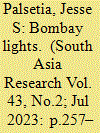

|
|
|
|
|
| Summary/Abstract |
Gas lighting, part of a re-envisioning of cities as modern metropoles, was one of the first ‘modern’ technologies implemented in nineteenth century Bombay. The debates over the implementation of gas light to illuminate the streets of Bombay have largely been overlooked in the history and historiography of colonial Bombay. Yet, the illumination of Bombay’s public streets with gas light was an important turning point in the transition of Bombay from a provincial outpost to a modern city. The article examines the related debates, presents the illumination of colonial Bombay with gas light as a metaphor for the emergence of the modern city and depicts how new processes regarding civic planning and development emerged from this gas light debate, which ultimately made the implementation of electrical light and other aspects of modern city life possible.
|
|
|
|
|
|
|
|
|
|
|
|
|
|
|
|
| 2 |
ID:
190670
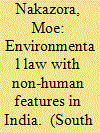

|
|
|
|
|
| Summary/Abstract |
Against the wider backdrop of a global acceleration of Right of Nature (RoN) legal provisions, this article focuses on recent Indian court cases that created legal personhood for the Ganges and Yamuna rivers, to explore why and how this form of legality was created. Based on anthropological fieldwork, the article then critiques contemporary assertions that simply present the Indian judgments as infiltrations of Hindu cosmology into the legal framework, basically ‘saffronisation’ of Indian environmentalism. Deeper analysis reveals the need for interdisciplinary, historically grounded study of processes of law-making and pertinent court rulings produced in Indian environmental jurisprudence.
|
|
|
|
|
|
|
|
|
|
|
|
|
|
|
|
| 3 |
ID:
190671
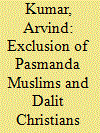

|
|
|
|
|
| Summary/Abstract |
Based on a re-reading of the Indian Constituent Assembly Debates in light of subsequent developments, this article provides new insights about the extent to which the Indian constitution allows affirmative action for redressing historical disadvantages and empowering marginalised communities. Since the post-colonial Indian state introduced the criterion of religion in the lists of Scheduled Castes (SCs), this sparked suspicions of efforts to prevent conversions, further augmenting India’s Hindu majority. The article re-examines such claims in light of the Indian Constituent Assembly Debates and subsequent Government Orders for notifying/modifying SCs. It argues that the list of SCs was never envisioned as religion-neutral, so that the exclusion of Pasmanda Muslims and Dalit Christians from the SCs is not a communal afterthought, while religion has all along not been the only or main criterion for affirmative action policies.
|
|
|
|
|
|
|
|
|
|
|
|
|
|
|
|
| 4 |
ID:
190672
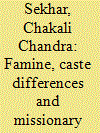

|
|
|
|
|
| Summary/Abstract |
This article sheds light on the conditions of Dalits, their experience of caste differences, discrimination and destitution during the Great Famine of 1876–78 in Rayalaseema, one of the Telugu-speaking regions of Madras Presidency. It highlights how existing caste practices defined and shaped famine relief measures, re-entrenching caste hierarchies. The caste location of Dalits aggravated the severity of their living conditions and social life in the village space and in relief works organised by the colonial government, which further reinforced caste inequalities and institutionalised social distancing. Consequently, Dalits experienced hunger, destitution and further marginalisation in society. During such conditions, the humanitarian concerns and charitable activities of missionaries had a profound impact on Dalits.
|
|
|
|
|
|
|
|
|
|
|
|
|
|
|
|
| 5 |
ID:
190673


|
|
|
|
|
| Summary/Abstract |
This article scrutinises to what extent land ownership improves the well-being of women, focusing on a village in Kerala, a South Indian state known for its land reforms ‘model’ that provided land to the tiller and ownership rights to tenants. However, have these radical land reforms actually succeeded in providing ownership rights to women, thereby contributing to their well-being? We ask in this intensive village study to what extent these admittedly radical land reforms provide adequate land rights to women in Kerala in terms of such ownership translating into absolute and effective rights.
|
|
|
|
|
|
|
|
|
|
|
|
|
|
|
|
| 6 |
ID:
190674
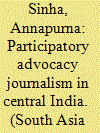

|
|
|
|
|
| Summary/Abstract |
This case study of a community newspaper, Namaskar, and its impact in ‘underdeveloped’ areas of coastal Odisha in India, discusses the potential of alternative media for social change. It scrutinises and analyses the participatory advocacy activities of Namaskar. Studying participatory journalism favours a more dialogical and reflexive approach, which also draws on ideas of ‘critical’ and ‘radical’ media, while also calling attention to the significance of content in bringing about social change. Building on observations and testimonies from the field, collected through multiple qualitative methods for data collection, the study infers that Namaskar ensures significant participation in its advocacy practices, leading to observable changes in and around its catchment area. However, basic gatekeeping and editing work to make news copy print-ready also restrain the extent of ‘absolute participation’.
|
|
|
|
|
|
|
|
|
|
|
|
|
|
|
|
| 7 |
ID:
190676
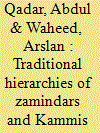

|
|
|
|
|
| Summary/Abstract |
This article challenges the traditional understanding of the role of landownership in rural Punjab in the context of recent socio-economic restructuring of Pakistani society. Based on extensive ethnographic fieldwork of contemporary practices of gift exchange (vartan bhanji) in a village, we argue that the Kammi biraderis, once considered lower class, now assert their elevated socio-economic status through vartan bhanji on important social occasions like marriages. Zamindars now see themselves in competition both with Kammi biraderis and each other for social prestige and superior status, as new claims made by different biraderis challenge traditional hierarchies created through historically structured socio-economic inequalities.
|
|
|
|
|
|
|
|
|
|
|
|
|
|
|
|
|
|
|
|
|